shaxper
CCF Site Custodian
Posts: 22,872
Member is Online
|
Post by shaxper on Nov 21, 2014 15:24:31 GMT -5
A Theory about the lack of alignment between Master of Kung Fu and Deadly Hands of Kung FuWhile it was standard practice for the magazine and comic book adaptations of the same Marvel character to not align (Tomb of Dracula/Dracula Lives!, Conan the Barbarian/Savage Sword of Conan), I think we have enough information to provide a slightly more in-depth explanation behind why little about Master of Kung Fu and Deadly Hands aligns, even to the peculiar extent that, while both depictions of Shang-Chi were written by Doug Moench, fans generally love one and generally can't stand the other. Consider the fact that, five issues into writing Deadly Hands of Kung Fu, Shang-Chi is still slowly walking north from Florida (after the events of MoKF#18 and 19), whereas he was back in New York with MoKF #20 (Moench's first issue) five months earlier. Consider also Moench's own explanation for how he got started at Marvel. As Moench wrote: So I accept the job. But there is also a catch on my end. Money. I do not have much of the stuff, and need a lot of it to accomplish the "permanent" move from Chicago to New York. How about if I quickly write a dozen 6-10 page "horror" stories for the fledgling line of Marvel black and white magazines? Would that cover expenses? Yes, I say, it would indeed. And so, newly ensconced in Manhatten, I work 9AM to 5PM in the Marvel offices, and 7PM to 2 or 3AM in my new apartment (seemingly rented by the square inch, its worth measured by weight in gold)--turning out a story a night. My life becomes nothing less than Work with a capital W, and nothing more than a Blur with a capital B. If he was so sorely in need of money, and Marvel was finding use for the output he was producing, it seems likely to me that Moench might maintain some semblance of this relationship with Marvel, doing regular bullpen work by day and churning out as many black and white magazine features as he could by night, at least in those first few weeks before he became inundated with regular assignments. We also know that Moench wasn't originally slated to take over on Master of Kung Fu. That was supposed to go to Gerry Conway. In fact, Conway wrote the first half of #20 before it was handed over to Moench. So consider this theory: Moench wrote many of the Deadly Hands of Kung Fu stories (including at least issues #3-7) in his first few weeks at Marvel BEFORE taking over on the regular Master of Kung Fu title. It would explain why the Deadly Hands stories appear to know the character less well, have less understanding of what to do with the feature, have writing that's more rough around the edges (Moench falls back on excessive internal monologues and overly used word play in a way that's consistent only with his first few MoKF stories), and, most noticeably, he still has Shang Chi slowly walking North across America whereas he's been back in New York for five months now (as of the issues I'm currently reviewing) in the core title. Might help to explain why so many here have said that, while they love Master of Kung Fu, they couldn't stand the Deadly Hands of Kung Fu stories. They're written by a slightly less experienced Moench still cutting his teeth on the property.
|
|
shaxper
CCF Site Custodian
Posts: 22,872
Member is Online
|
Post by shaxper on Nov 21, 2014 15:43:56 GMT -5
The Deadly Hands of Kung Fu #7 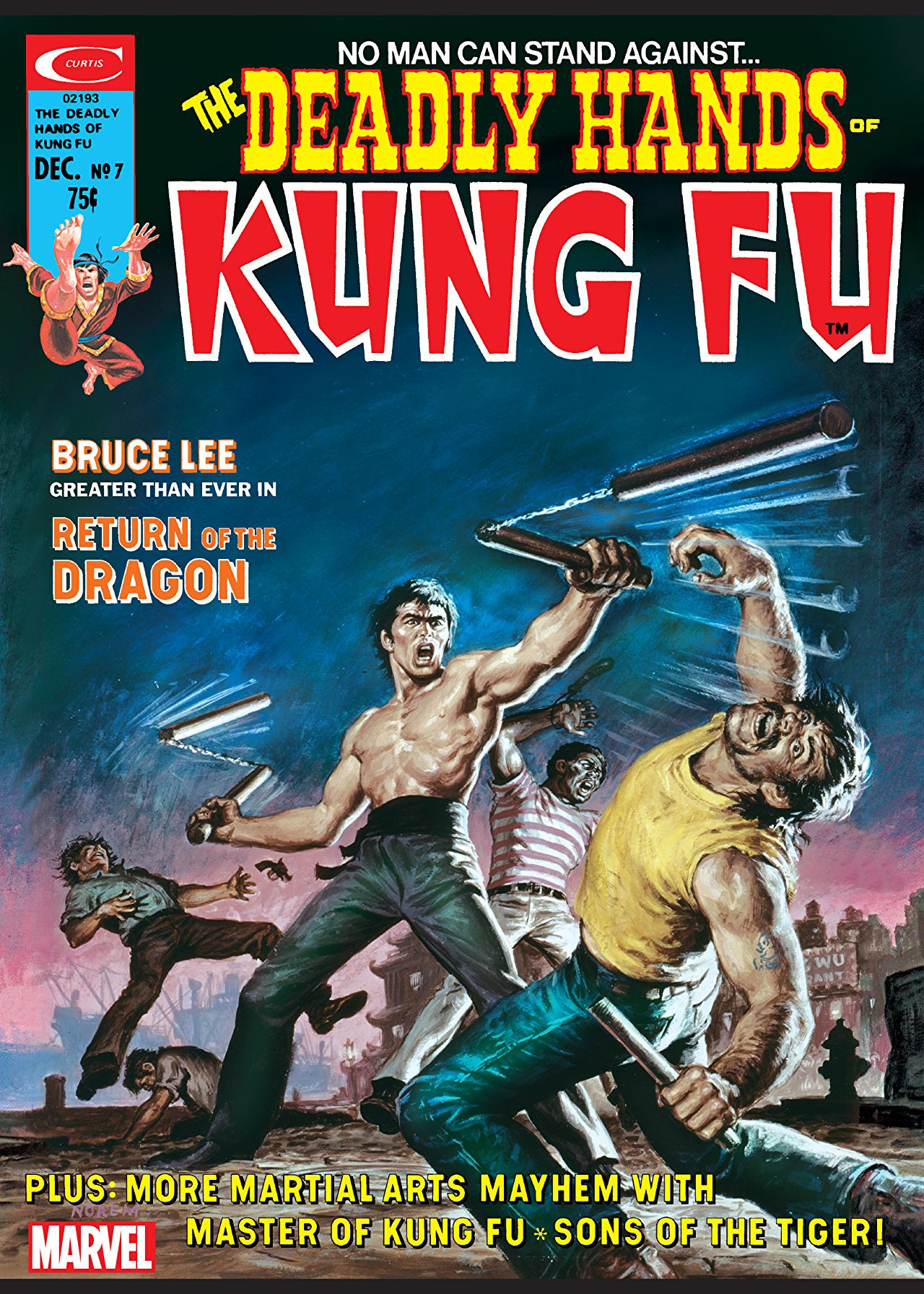 "Past-Assassins!" writer: Doug Moench pencils: Mike Vosberg inks: Al Milgrom grade: C Vosberg does a far better job of drawing Shang-Chi with this story, and he has a lot more fun with panel arrangements to boot. He's no P. Craig Russell, but his efforts are still fun and appreciated. Moench, meanwhile, continues to amble through these Deadly Hands of Kung Fu stories just as Shang-Chi ambles through America, unsure of where he's going and not entirely concerned with the matter either. This plot felt particularly jumbled and, per usual, did little more than to provide opportunities for fighting. No exploration with Shang-Chi as a character, no real concern for Fu Mancu's depiction either, and no real plot to sink our teeth into. If you're reading a martial arts magazine because you like fighting, this script did its job. But, really, Doug? "Mr. Man" as the antagonist last issue, followed by "Mr. Boss" in this one? At least pretend to try, please. Finally, I DO like Fu Manchu's remarks at the end, but they really don't match the relationship we've watched play out in the last two issues of Master of Kung Fu: Ducharme: You are not filled with rage, O' celestial one...?
Fu Manchu: No, Ducharme, only with pride...for the flesh of my flesh. And anticipation--for a most interesting ultimate confrontation between father and son.Fu Manchu seems far less interested in Shang-Chi as anything other than an antagonist in the MoKF stories we've seen as of late: the cold, detached father as opposed to one with oddly mixed emotions towards his son. I prefer this approach, and that's probably the first and last time I'll go on record as saying there's something about Deadly Hands of Kung Fu that I prefer to Master of Kung Fu. plot synopsis: Standard generic Deadly Hands of Kung Fu plot: Shang Chi fights more dudes, Fu Manchu is somehow involved, and Shang-Chi gets away victorious. |
|
shaxper
CCF Site Custodian
Posts: 22,872
Member is Online
|
Post by shaxper on Jan 20, 2015 18:03:39 GMT -5
Master of Kung Fu #25 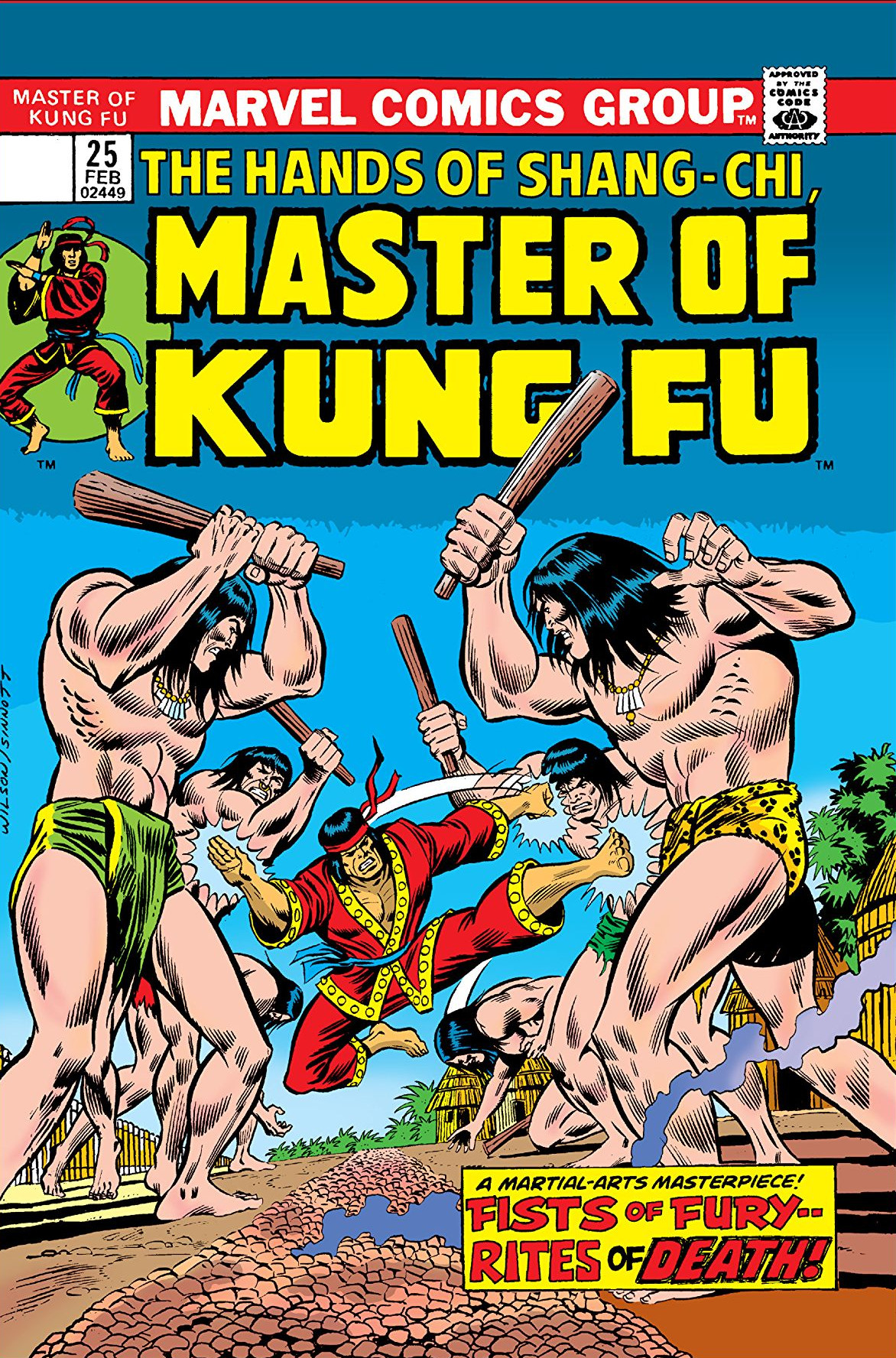 "Rites of Courage, Fists of Death!" writer: Doug Moench pencils: Paul Gulacy inks: Sal Trapani letters: John Costanza colors: Bill Mantlo (HUH??!!) editor: Roy Thomas grade: C- Gulacy takes over as full time penciler with this issue, and yet his art is remarkably crude and awkward when compared to the fine marriage of words and art we saw in Giant Size #2. Come to think of it, Moench's sense of Shang-Chi and of the title feels under-developed compared to that issue, as well. I begin to wonder if, just as I speculated that All the Deadly Hands of Kung Fu stories up to this point were written prior to Moench taking over on Master of Kung Fu, this issue was written and penciled prior to GS #2. There really isn't much to say about this forgettable issue beyond that, except that we see Moench still struggling to understand Shang Chi as a character. He's pretty much abandoned the deeply philosophical internal narration he lent to Shang Chi in his first few stories and, for the moment, seems to understand that Shang Chi shouldn't be heavy on dialogue, so instead he spends most of the issue internally reflecting on his training and decisions when fighting and when observing. It's just a tad bland. The protagonist utterly lacks character in a franchise that's supposed to be focused entirely on the rising and advancing of his spirit. It's a significant deficit at this point. plot synopsis in one sentence: In the wake last issue, Nayland Smith, Blackjack Tar, and Shang-Chi are on their way out of the jungle when Shang-Chi overhears a crying baby, saves it from a leopard, returns it to its village, learns that the villagers intend to sacrifice it, and ends up enduring trials to prove that he was sent by the tribe's god in order to save the infant's life, all while an upstart challenger to the village elder attempts to use distrust of Shang-Chi to his advantage, ultimately killing the village elder and forcing Shang Chi to combat the tribe's warriors, ultimately leaving the village in awe and content to do whatever Shang Chi says, believing he is a god himself. |
|
|
|
Post by paulie on Jan 20, 2015 18:34:20 GMT -5
Master of Kung Fu #25  "Rites of Courage, Fists of Death!" writer: Doug Moench pencils: Paul Gulacy inks: Sal Trapani letters: John Costanza colors: Bill Mantlo (HUH??!!) editor: Roy Thomas grade: C- Gulacy takes over as full time penciler with this issue, and yet his art is remarkably crude and awkward when compared to the fine marriage of words and art we saw in Giant Size #2. Come to think of it, Moench's sense of Shang-Chi and of the title feels under-developed compared to that issue, as well. I begin to wonder if, just as I speculated that All the Deadly Hands of Kung Fu stories up to this point were written prior to Moench taking over on Master of Kung Fu, this issue was written and penciled prior to GS #2. There really isn't much to say about this forgettable issue beyond that, except that we see Moench still struggling to understand Shang Chi as a character. He's pretty much abandoned the deeply philosophical internal narration he lent to Shang Chi in his first few stories and, for the moment, seems to understand that Shang Chi shouldn't be heavy on dialogue, so instead he spends most of the issue internally reflecting on his training and decisions when fighting and when observing. It's just a tad bland. The protagonist utterly lacks character in a franchise that's supposed to be focused entirely on the rising and advancing of his spirit. It's a significant deficit at this point. plot synopsis in one sentence: In the wake last issue, Nayland Smith, Blackjack Tar, and Shang-Chi are on their way out of the jungle when Shang-Chi overhears a crying baby, saves it from a leopard, returns it to its village, learns that the villagers intend to sacrifice it, and ends up enduring trials to prove that he was sent by the tribe's god in order to save the infant's life, all while an upstart challenger to the village elder attempts to use distrust of Shang-Chi to his advantage, ultimately killing the village elder and forcing Shang Chi to combat the tribe's warriors, ultimately leaving the village in awe and content to do whatever Shang Chi says, believing he is a god himself. Sal Trapani's inks are crude more than anything else. Dan Adkins will be along soon enough as will Razor-Fist... |
|
|
|
Post by Cei-U! on Jan 20, 2015 18:38:50 GMT -5
Sal Trapani massacred Gulacy's pencils. One of my least favorite inkers ever.
And Bill Mantlo did indeed start out as a colorist (as did Steve Engelhart).
Cei-U!
I summon the seriously obscure credits!
|
|
|
|
Post by Rob Allen on Jan 20, 2015 19:14:29 GMT -5
I remember when Mantlo started scripting - in Deadly Hands of Kung Fu, I think - fans were wondering why they let a colorist write some stories.
|
|
|
|
Post by berkley on Jan 20, 2015 19:52:01 GMT -5
I remember when Mantlo started scripting - in Deadly Hands of Kung Fu, I think - fans were wondering why they let a colorist write some stories. He should have filled every sentence with words related to colours in his first story, just to confirm their doubts: "The red and yellow clad stranger walks down the grey streets beneath a leaden sky, also grey, but a slightly lighter shade, kind of a pale blue, really, ..." |
|
shaxper
CCF Site Custodian
Posts: 22,872
Member is Online
|
Post by shaxper on Jan 26, 2015 15:38:22 GMT -5
Deadly Hands of Kung Fu #8 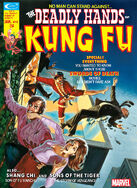 "A Hatred for All Seasons!" writer: Doug Moench pencils: Mike Vosburg inks: Jack Abel grade: C+ Well this one definitely fits my theory that the Deadly Hands of Kung Fu stories were written before Moench even began on the MoKF title. It has all the trappings of Moench's earliest Shang-Chi stories, with Shang-Chi narrating the story with overly philosophical ideas and excessive word-play, as well as Shang Chi repeatedly being disappointed by the humanity he witnesses while walking the streets, a story built around one strong visual concept, and, of course, Shang-Chi STILL walking through San Francisco on his way back from Florida (he's been back in New York for six months now in the regular MoKF title). This is definitely an early Shang-Chi installment. That being said, it isn't a terrible one. Moench tries hard to make a point about perspective and social injustice by framing the story from two perspectives (one belonging to Shang Chi, one to a character who, initially, feels like Blockbuster from the pages of Batman), and I really enjoyed the visual concept at the center of this story -- Shang-Chi repeatedly beating the monster as he attempts to climb out of a swimming pool until he'll see reason. It makes for a very powerful moment; you can almost smell Shang Chi's frustration that he has to keep beating this creature to the point of nearly drowning because it refuses to see reason. But then the story goes downhill fast. Somehow, this improbably large behemoth with the terrifyingly disfigured face tells his tale in an excess of falling action that wasn't really needed, and somehow he used to be a totally normal cop who just started wandering the streets and murdering people because his partner was killed by mistake. The motivation makes no sense, nor does this character match the behemoth Shang-Chi was facing off with for most of the issue. It's possible some of the fault lies with Vosburg, but, really, this story is indecisive about who this character is and what drives him from the getgo, suggesting both that he's hideous and that economic inequality is the source of his rage in the early pages of the script. And, of course, Moench has no grasp on who Shang-Chi is at this point beyond his being a pacifist. Vosburg's art continues to grow on me, though. He's no Gulacy, but check out some of his striking panel arrangements in this story: 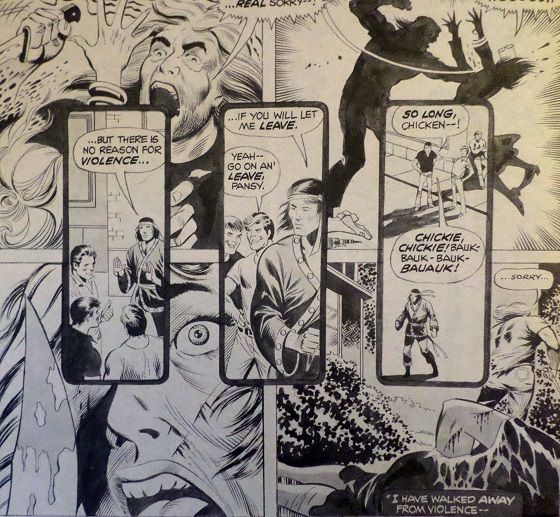 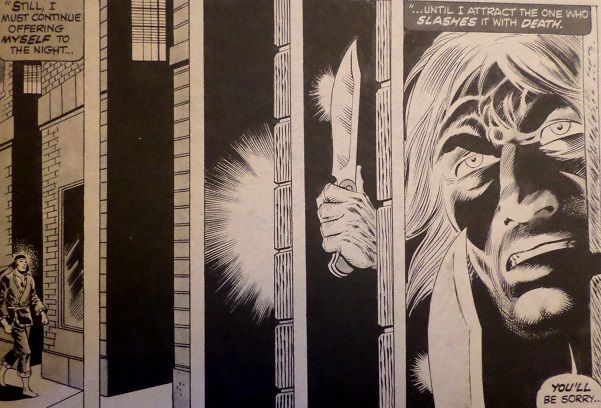 And I still can't decide whether this shot of Shang-Chi in action is brilliant or awkward looking: 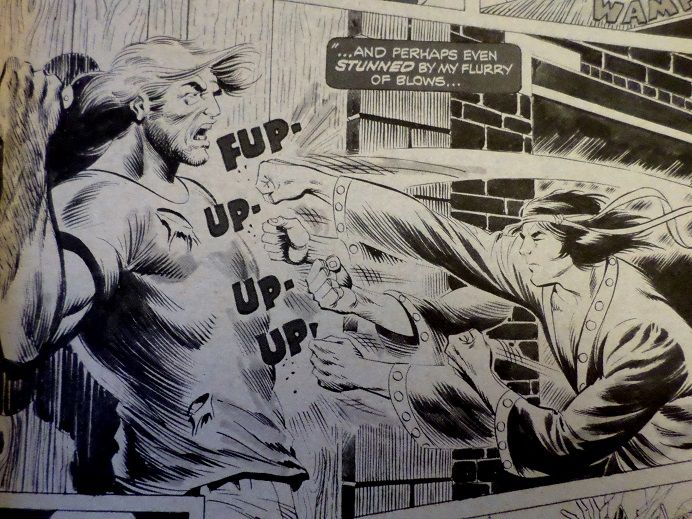 Overall, one of the better of Moench's early filler stories, but it certainly has its flaws. plot synopsis in one sentence: Shang-Chi walks down the nice streets of San Francisco in parallel to a raging behemoth walking down the run down streets of San Francisco, the behemoth murders anyone who gives him a hard time, Shang-Chi ultimately sees and tries to stop him, they face off in a gym where Shang-Chi throws him into a pool and refuses to let him out until he sees reason, the behemoth suddenly reveals his whole back story, feeling that life has led him to become a raging murderer, the two become friends, and the police arrive and suddenly kill the behemoth, assuming he's a threat, and also proving the behemoth's point, which drives Shang-Chi into a brief uncharacteristic rage. |
|
shaxper
CCF Site Custodian
Posts: 22,872
Member is Online
|
Post by shaxper on Jan 31, 2015 11:34:18 GMT -5
Master of Kung Fu #26 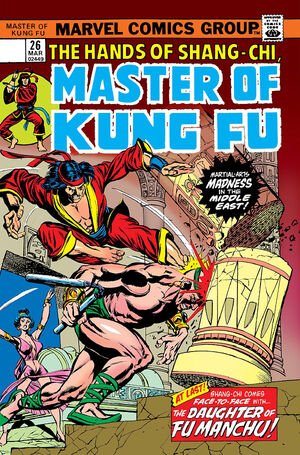 "Daughter of Darkness!" writer: Doug Moench pencils: Keith Pollard inks: Sal Trapani letters: Charlotte Jetter colors; George Roussos editor: Len Wein grade: A- AND we're back to the good stuff! Moench is definitely firing on the right cylinders this issue, the plot is more ambitious and interesting than usual, and even guest penciler Keith Pollard (I guess they still hadn't settled on Gulacy yet) and colorist George Roussos bring impressive quality to the story. This is definitely the kind of caliber work we saw in Giant-Size #2. I've made the case before that Len Wein was a great editor and largely responsible for all the greatness of the late Bronze Age Batman and New Teen Titans; I wonder if this sudden rise in quality with Master of Kung Fu can be attributed to his taking over as editor with this issue? If nothing more, there's a common thread of Wein as Editor and Moench as writer here and with Batman; clearly there was a synergy. As for the story itself, I'd often wondered if this series was going to disregard the fact that, while the Sax Rohmer books never mention a son named Shang-Chi, they do give clear attention to daughter Fah So Luee; a daughter who had never been mentioned in the comic books prior to now. Clearly, Moench has finally begun doing his homework on the Fu Manchu stories, or at least is getting good assistance from someone (perhaps Wein). The story is a simple one, but Moench's writing is so fluid, Fah So Luee is so compelling, and Pollard's art is so kinetic, that it was incredibly fun all the same. A few favorite moments: 1. Moench's description of Fah Lo Suee For anyone who's ever mocked me for choosing Moench as my favorite comic writer of all time, case in point. 2. Sure, you can narrate a fight scene, but can you make slipping interesting?  3. More insight into Shang-Chi's childhood. I'm a sucker for learning more about who he is by exploring where he's been. 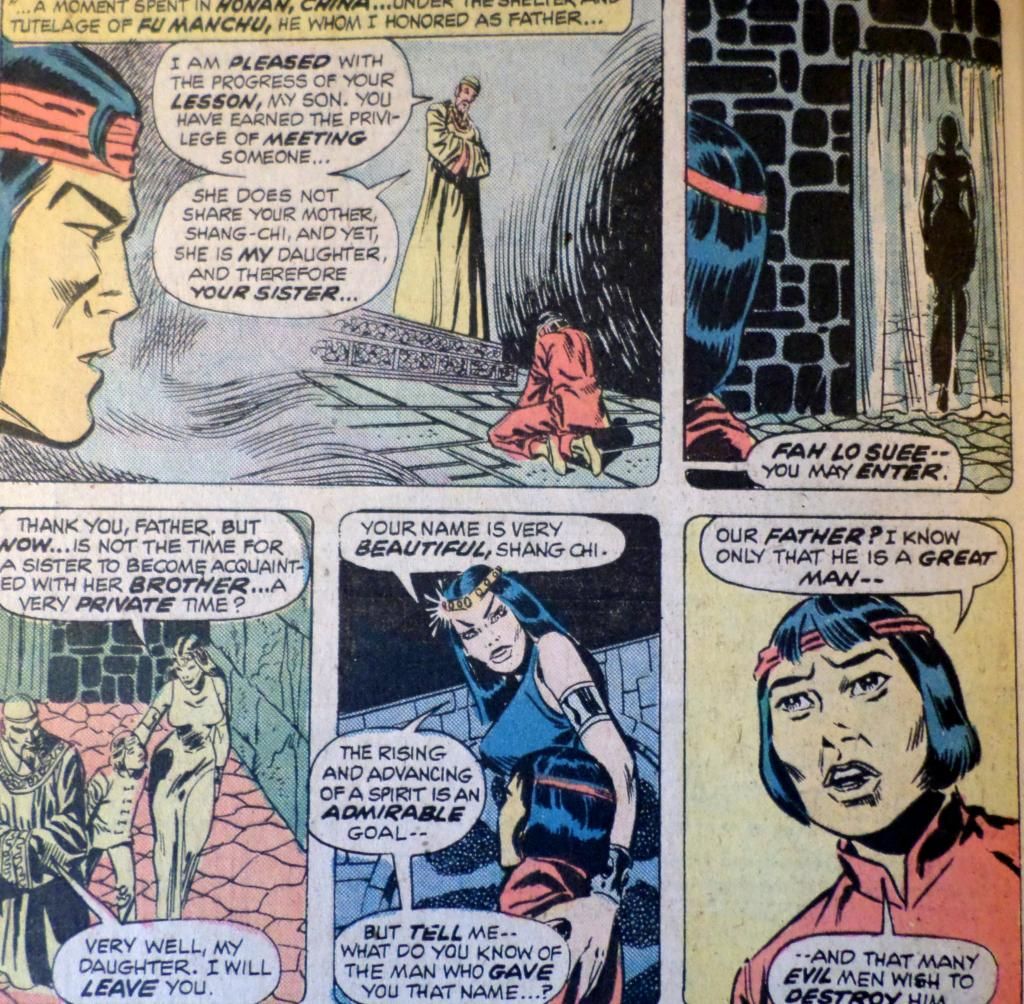 Not pictured is her reply to Shang-Chi's statement: 4. Those little details, like an elaborate fight occurring between Shang-Chi and an opponent, at some point which Shang-Chi manages to disarm him. Immediately after, Shang-Chi drops down from the apartment where this took place to find Sir Dennis very realistically in the middle of a sentence AND picking up the lost nunchucku. A minor detail, to be sure, but it just made the story feel all the more realistic. Dennis' life continues even when Shang-Chi and the comic itself aren't with him, and all weapons discarded in the middle of a fight scene have to go somewhere. Really, the only thing still lacking in this story is that Shang-Chi still isn't showing much development as a character. As we learn how detached he is from his own sister in the flashback, and as we watch a heated struggle among the three people who have all demanded his loyalty (Fu Manchu, Neyland Smith, and Fah Lo Suee), I'd expect to see a little more rising of his spirit in this story, or at least a reaffirmation of what he believes. But even Moench seems to sense this absence by the close, ending the story with: "Thus, the struggle between father and daughter has ended...forever...or for now. And in the question, I find that my spirit has not risen this night." Important Details: 1st comic appearance of Fah Lo Suee, Fu Manchu's daughter, who does not age and has hypnotic powers when one looks into her eyes. Minor Details: - Let's be clear that, in all the time since the events of Marvel Special Edition #15, Shang-Chi has owned exactly one set of clothing, and (as far as we know) he's still homeless. I've no doubt his spirit and body are both advanced enough to tolerate extreme amounts of sweat and dirt without experiencing either discomfort or illness, but shouldn't the people near him begin to notice, especially as Nayland Smith plans to have Shang-Chi meet him at a nice restaurant in this issue? And, after all those fights, shouldn't his clothes be a little tattered? - Here's a fascinating write-up on Fah Lo Suee's presence in MoKF, in part discussing this very issue: www.hypnosisinmedia.com/blog/520/fa-lo-suee-master-kung-fu/- I've never paid much attention to regular letter writers before, or (as they're more often called around here) letter hacks, but Bill Wu's letter in this issue instantly made me a fan of his: As you may or may not know, I've severely criticized MASTER OF KUNG FU, primarily for depicting Asians and Chinese culture in a negative way. Since a number of your issues have come out, I thought I'd let you know that I'm experiencing the first faint twinges of approval. Most particularly, I enjoyed #23, "River of Death." There are two reasons for this: first, I feel that the inclusion of racism in the plot, rather than in occasional throw-away lines, maintains a healthy focus. I feel that the presence of Fu Manchu as a villain unavoidably results in an anti-Chinese tendency, and when the racism is not inherent in the plot, it may strike the reader in an unconscious, and therefore dangerous, way. Keeping the reader aware of the issue is something I appreciate very much, though I realize it won't be consistently possible. The other reason I liked the story is even less possible to maintain: the near-absence of old Fu Manchu form the artwork, if not the script. I do have a particular suggestion for making Fu Manchu a little more palatable to those of us who recognize him as the only representative, however fake, of traditional China in the comic world. If you've read the books, you know the one credo which Fu Manchu regarded as his law: his word was inviolate. The reinstitution of this trait would make even the "most evil villain of all time" a little more human, deepening his character and perhaps offering more intricacy of plot in the distant future. In any case, I thought I'd pass along the above opinions. If you could possibly spare the time, I'm curious about how you view the book in general. And I promise--no vitriolic blasts if our opinions differ, as I expect they might. Bill Wi 316 Madison #15 Ann Arbor, MI 48104 Well said, Bill. Especially the second to last paragraph. All in all, Master of Kung Fu is starting to come along. I'm excited for more. plot synopsis in one sentence: Smith and Shang-Chi are in Egypt, pursuing Fu Manchu, Smith reunites with the son of his old friend, Shan Greville, who explains that Fah Lo Suee, Fu Manchu's daughter has visited him, it becomes apparent that she is controlling his mind as he works an archaeological dig into the crypt of Seth Amon so that he will steal for her two ruby eyes with which one can control minds, we get a flashback of Shang-Chi first meeting her as a child and her informing him that she'd one day ask him to help betray their father, after a few battles we get a final throwdown in the crypt among Shang-Chi, Fah Lo Suee, and Fu Manchu's Si-Fan agents before the crypt is blown to bits, leaving Shang-Chi and Sir Dennis to wonder if Fah Lo Suee was killed or got away. |
|
|
|
Post by Cei-U! on Jan 31, 2015 12:00:18 GMT -5
Len Wein was the editor of the entire Marvel line during this period and, like Roy Thomas before him and Marv Wolfman after him, had almost no input into those titles he wasn't himself scripting. So, unlike his later DC work, you really can't lay any credit for MoKF's improvement on Len. Doug Moench had by this point earned enough trust from editorial to be essentially self-editing, a status quo that remained until Jim Shooter became EIC.
Cei-U!
I summon the peek behind the scenes!
Also? It's "case IN point," not "case AND point."
|
|
shaxper
CCF Site Custodian
Posts: 22,872
Member is Online
|
Post by shaxper on Jan 31, 2015 12:13:26 GMT -5
Also? It's "case IN point," not "case AND point." Well, it would be if my case and my point weren't the same  |
|
shaxper
CCF Site Custodian
Posts: 22,872
Member is Online
|
Post by shaxper on Jan 31, 2015 12:29:01 GMT -5
Bringing Up Shang-ChiAn exploration of his childhood and tutelage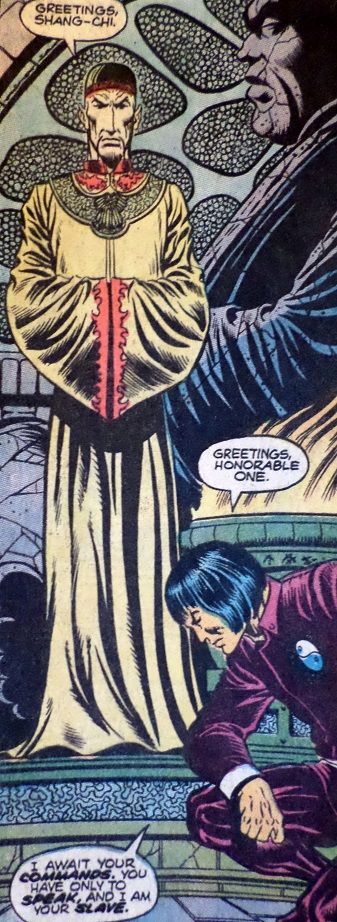 Special Marvel Edition #15 first introduces us to Shang-Chi and explains that he's spent the past 19 years of his life training at Fu Manchu's Honan retreat prior to that story, but what happened before that? This will be a constantly maintained chronology of all references made to Shang-Chi's early life in the pages of Master of Kung Fu and Deadly Hands of Kung Fu as I proceed through both series.Early Childhood: Special Marvel Edition #15 first introduces us to Shang-Chi and explains that he's spent the past 19 years of his life training at Fu Manchu's Honan retreat prior to that story, but what happened before that? This will be a constantly maintained chronology of all references made to Shang-Chi's early life in the pages of Master of Kung Fu and Deadly Hands of Kung Fu as I proceed through both series.Early Childhood: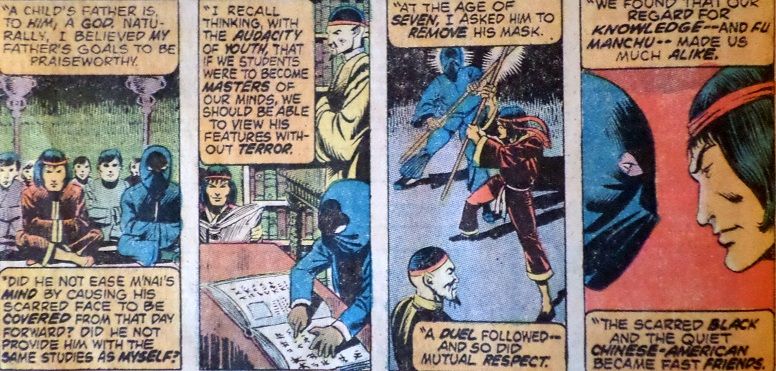 Early training and the befriending of M'Nai (dies in Special Marvel Edition #16) Special Marvel Edition #16 offers us this brief flashback. No year or age is given. Perhaps our one clue to a possible time reference is that Shang-Chi is studying with pupils. Our next flashback implies (though does not directly state) that Shang-Chi was training individually by the age of ten. Age Ten: The first encounter with Fah Lo Suee. Note: Deadly Hands of Kung Fu #1 strongly suggests Shang-Chi had little contact with his father and trained under four priests who were directed by Fu Manchu. However, this issue and the one that follows (MoKF #27) make it clear that Fu Manchu trained and tutored Shang-Chi himself. Master of Kung Fu #26 indicates this occurred ten years earlier (and Shang-Chi is currently twenty, having been nineteen in Special Marvel Edition #15 and receiving a birthday since). Age Fourteen: First inkling that Fu Manchu may not be entirely just after his father decides to test his morals by forcing Shang-Chi to kill other loyal Si-Fan members. We also learn that, by this point, Shang-Chi was receiving his education exclusively from four priests, the favorite of which was Cho Lin until this moment. Deadly Hands of Kung Fu #1 repeatedly states this occurred at age 14. Age Nineteen:Special Marvel Edition #15 and all that has followed.
|
|
|
|
Post by paulie on Jan 31, 2015 13:02:17 GMT -5
Master of Kung Fu #26  "Daughter of Darkness!" writer: Doug Moench pencils: Keith Pollard inks: Sal Trapani letters: Charlotte Jetter colors; George Roussos editor: Len Wein grade: A- AND we're back to the good stuff! Moench is definitely firing on the right cylinders this issue, the plot is more ambitious and interesting than usual, and even guest penciler Keith Pollard (I guess they still hadn't settled on Gulacy yet) and colorist George Roussos bring impressive quality to the story. This is definitely the kind of caliber work we saw in Giant-Size #2. I've made the case before that Len Wein was a great editor and largely responsible for all the greatness of the late Bronze Age Batman and New Teen Titans; I wonder if this sudden rise in quality with Master of Kung Fu can be attributed to his taking over as editor with this issue? If nothing more, there's a common thread of Wein as Editor and Moench as writer here and with Batman; clearly there was a synergy. As for the story itself, I'd often wondered if this series was going to disregard the fact that, while the Sax Rohmer books never mention a son named Shang-Chi, they do give clear attention to daughter Fah So Luee; a daughter who had never been mentioned in the comic books prior to now. Clearly, Moench has finally begun doing his homework on the Fu Manchu stories, or at least is getting good assistance from someone (perhaps Wein). The story is a simple one, but Moench's writing is so fluid, Fah So Luee is so compelling, and Pollard's art is so kinetic, that it was incredibly fun all the same. A few favorite moments: 1. Moench's description of Fah So Luee For anyone who's ever mocked me for choosing Moench as my favorite comic writer of all time, case in point. 2. Sure, you can narrate a fight scene, but can you make slipping interesting?  3. More insight into Shang-Chi's childhood. I'm a sucker for learning more about who he is by exploring where he's been.  Not pictured is her reply to Shang-Chi's statement: 4. Those little details, like an elaborate fight occurring between Shang-Chi and an opponent, at some point which Shang-Chi manages to disarm him. Immediately after, Shang-Chi drops down from the apartment where this took place to find Sir Dennis very realistically in the middle of a sentence AND picking up the lost nunchucku. A minor detail, to be sure, but it just made the story feel all the more realistic. Dennis' life continues even when Shang-Chi and the comic itself aren't with him, and all weapons discarded in the middle of a fight scene have to go somewhere. Really, the only thing still lacking in this story is that Shang-Chi still isn't showing much development as a character. As we learn how detached he is from his own sister in the flashback, and as we watch a heated struggle among the three people who have all demanded his loyalty (Fu Manchu, Neyland Smith, and Fa Lo Suee), I'd expect to see a little more rising of his spirit in this story, or at least a reaffirmation of what he believes. But even Moench seems to sense this absence by the close, ending the story with: "Thus, the struggle between father and daughter has ended...forever...or for now. And in the question, I find that my spirit has not risen this night." Important Details: 1st comic appearance of Fa Lo Suee, Fu Manchu's daughter, who does not age and has hypnotic powers when one looks into her eyes. Minor Details: - Let's be clear that, in all the time since the events of Marvel Special Edition #15, Shang-Chi has owned exactly one set of clothing, and (as far as we know) he's still homeless. I've no doubt his spirit and body are both advanced enough to tolerate extreme amounts of sweat and dirt without experiencing either discomfort or illness, but shouldn't the people near him begin to notice, especially as Nayland Smith plans to have Shang-Chi meet him at a nice restaurant in this issue? And, after all those fights, shouldn't his clothes be a little tattered? - Here's a fascinating write-up on Fa Lo Suee's presence in MoKF, in part discussing this very issue: www.hypnosisinmedia.com/blog/520/fa-lo-suee-master-kung-fu/- I've never paid much attention to regular letter writers before, or (as they're more often called around here) letter hacks, but Bill Wu's letter in this issue instantly made me a fan of his: As you may or may not know, I've severely criticized MASTER OF KUNG FU, primarily for depicting Asians and Chinese culture in a negative way. Since a number of your issues have come out, I thought I'd let you know that I'm experiencing the first faint twinges of approval. Most particularly, I enjoyed #23, "River of Death." There are two reasons for this: first, I feel that the inclusion of racism in the plot, rather than in occasional throw-away lines, maintains a healthy focus. I feel that the presence of Fu Manchu as a villain unavoidably results in an anti-Chinese tendency, and when the racism is not inherent in the plot, it may strike the reader in an unconscious, and therefore dangerous, way. Keeping the reader aware of the issue is something I appreciate very much, though I realize it won't be consistently possible. The other reason I liked the story is even less possible to maintain: the near-absence of old Fu Manchu form the artwork, if not the script. I do have a particular suggestion for making Fu Manchu a little more palatable to those of us who recognize him as the only representative, however fake, of traditional China in the comic world. If you've read the books, you know the one credo which Fu Manchu regarded as his law: his word was inviolate. The reinstitution of this trait would make even the "most evil villain of all time" a little more human, deepening his character and perhaps offering more intricacy of plot in the distant future. In any case, I thought I'd pass along the above opinions. If you could possibly spare the time, I'm curious about how you view the book in general. And I promise--no vitriolic blasts if our opinions differ, as I expect they might. Bill Wi 316 Madison #15 Ann Arbor, MI 48104 Well said, Bill. Especially the second to last paragraph. All in all, Master of Kung Fu is starting to come along. I'm excited for more. plot synopsis in one sentence: Smith and Shang-Chi are in Egypt, pursuing Fu Manchu, Smith reunites with the son of his old friend, Shan Greville, who explains that Fa Lo Suee, Fu Manchu's daughter has visited him, it becomes apparent that she is controlling his mind as he works an archaeological dig into the crypt of Seth Amon so that he will steal for her two ruby eyes with which one can control minds, we get a flashback of Shang-Chi first meeting her as a child and her informing him that she'd one day ask him to help betray their father, after a few battles we get a final throwdown in the crypt among Shang-Chi, Fa Lo Suee, and Fu Manchu's Si-Fan agents before the crypt is blown to bits, leaving Shang-Chi and Sir Dennis to wonder if Fa Lo Suee was killed or got away. It wasn't that Gulacy hadn't been decided on yet... He was busy pencilling the terrific Giant-Sized issues which were released concurrently. A couple of quick points. *Fa Lao Suee is a good character and has a good introduction here. *Bill Wu's letters get even more cogent and are worth looking forward to as much as the actually story itself. Same with Ed Via's letters and likewise, Cat Yronwode's. *Keith Pollard is underrated. Once Kirby left and Marvel adopted John Buscema's art as the de facto Marvel House Style Keith Pollard was maybe the one guy who most diligently adhered to that dictum. *Sal Trapani was just terrible. I know he moved over to DC at some point. Did he ever improve? *The next issue features the terrific pair of John Buscema and Frank Springer. I think it was the only time they worked together. *You are finally on to the good stuff... Giant-Size #3, I think, comes next. |
|
|
|
Post by paulie on Jan 31, 2015 13:03:35 GMT -5
Oh... and Len Wein also brought Alan Moore over to Swamp Thing and settled on the Cockrum-Grainger pairing for the all-new, all-different X-Men.
|
|
|
|
Post by berkley on Jan 31, 2015 16:16:54 GMT -5
MoKF had one of the best letters pages ever, and Bill Wu was an important contributor to making that so. You have many more insightful commentaries to look forward to from Mr Wu and several other regular letter writers.
Actually, most of the more thoughtful Marvel series back in the 70s had letter pages that were a treat to read and I looked forward to them every issue. It was both fun and educational for someone like myself to enjoy access to the thoughts of older, more experienced readers on these stories we all loved so much. The letters page of MoKF and other series greatly enhanced my appreciation of those comics and introduced me to a lot of stuff I wouldn't have heard of otherwise, at least not for some years.
|
|














